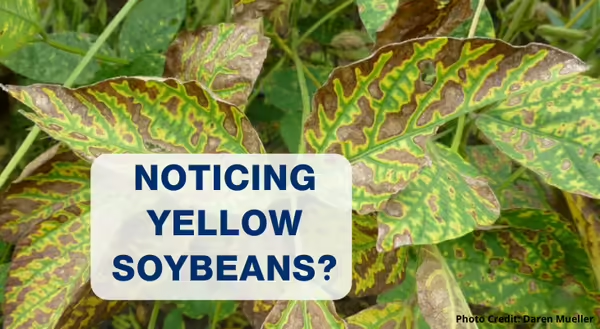
We’re at a point in the growing season where it is still a little early for soybeans to start senescing and turn yellow (dependent on maturity group, planting date, and growing conditions), so it makes you question why are yellow soybeans appearing in fields? There are several factors that can cause soybean leaves to turn yellow and drop.
Diseases such as sudden death syndrome (SDS) and brown stem rot (BSR) are often noticeable later in the season when the leaves of the soybean plants begin showing symptoms of chlorotic or yellow leaf tissue leading to interveinal necrosis (dead tissue between veins). SDS and BSR look very similar which requires further investigation to correctly identify the disease. To better identify these diseases, split the stem of the plant; a plant with SDS will likely have grey-brown vascular tissue in the roots, but the pith will remain white. It may also develop a blue color on infected roots. Plants infected with BSR will have dark reddish-brown centers.
Both SDS and BSR are soil borne fungal diseases that prefer a cool, moist environment with infection occurring early in the season and symptoms appearing around flowering. Variety selection for tolerance to SDS and BSR is important; take note of problem fields and choose varieties accordingly. For SDS control, fungicides applied in-furrow or as seed treatments can be used at planting; fungicides applied later in season have little effect on SDS or BSR control as infection occurs in the roots. When soils are cool and wet at planting, seedlings are more susceptible to infection. It is best to plant fields with no history of SDS first followed by fields with a history; this allows for the soil to warm up more. Fields with BSR benefit from longer crop rotations (more than one year away from soybean); however, SDS is not affected by rotation.
Soybean cyst nematode (SCN) is another potential cause for soybeans turning yellow. Conditions favoring SCN are continuous soybeans or soybeans grown in every other year rotation with added stress factors. It is estimated that SCN is present at some level in 85% of fields throughout the state of Illinois. Infected plants may become yellow and stunted. To diagnose if SCN is the issue, it is necessary to dig plants and look for cysts on the roots. Cysts are a tiny, white to yellow, lemon-shape; they can easily be confused with nodules on the root; however, the cysts are smaller than nodules. Soil sampling for SCN can also be used to identify if it is present in your field. SCN resistant varieties are available; however, resistance to these genes has become an issue which highlights the importance of rotating between resistant genes. Crop rotation to a nonhost crop is also an option; however, the nematodes will remain in the soil. It is important to monitor fields and take note of fields with SCN pressure; these fields should either be planted last, or equipment should be cleaned before moving to another field; it is also important to know that tillage equipment will spread cysts throughout the field. Because SCN attack the root system, it makes the plant more susceptible to soil borne diseases such as SDS and BSR.
Other issues that can show symptoms of yellowing include compaction, nutrient deficiencies, drought stress, other plant diseases, or low lying, wet areas; the ones I touched on here are some of the more common issues. With so many possible factors, correct diagnosis is key to controlling issues in your field. If you need assistance, contact your local Extension office. The University of Illinois Plant Clinic also does plant and insect identification; diagnosis of disease; insect, weed and chemical injury (chemical injury on field crops only); nematode assays; and help with nutrient related problems; as well as, recommendations involving these diagnoses.
Please take a moment to give us some feedback on Good Growing. Take the Good Growing Survey!
Want to get notified when new Good Growing posts are available? SIGN UP HERE!